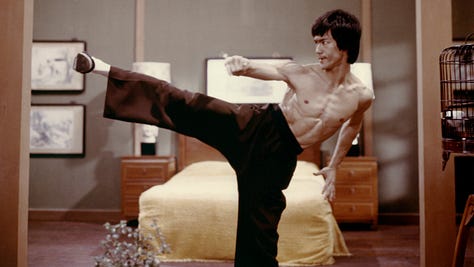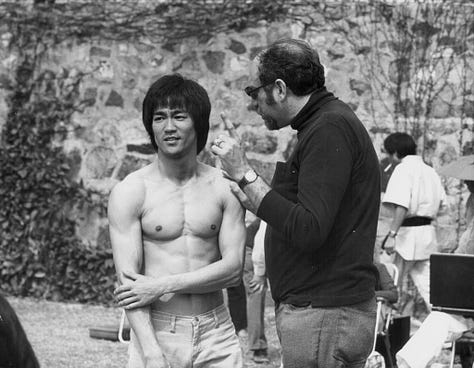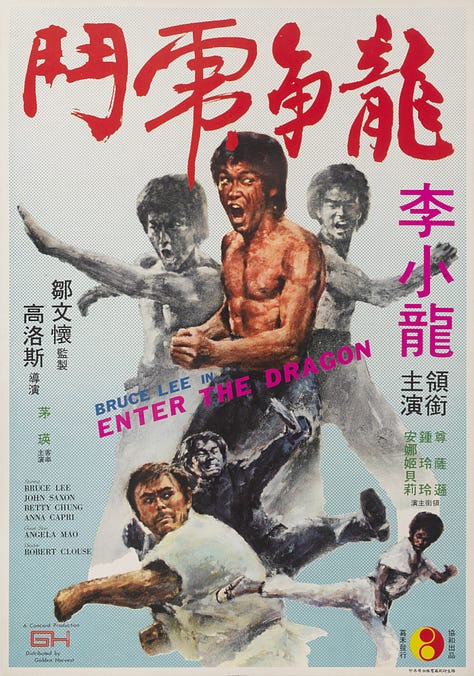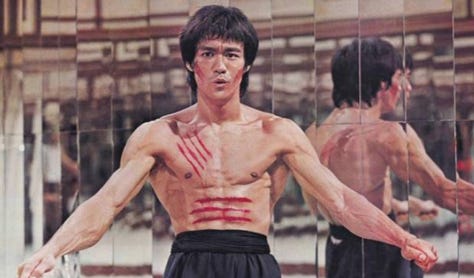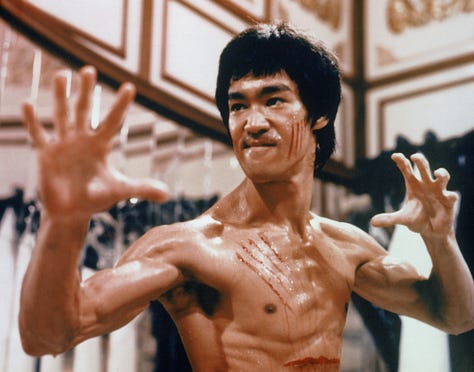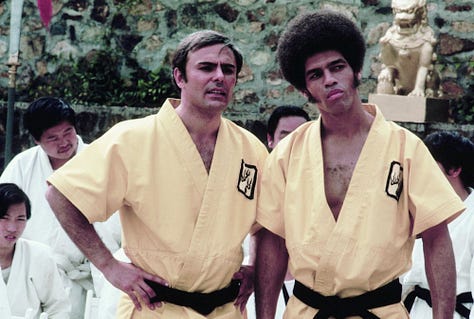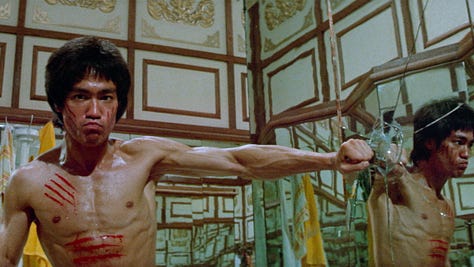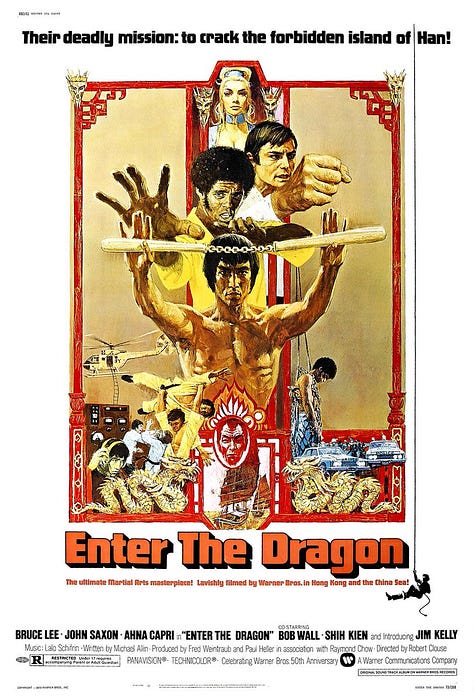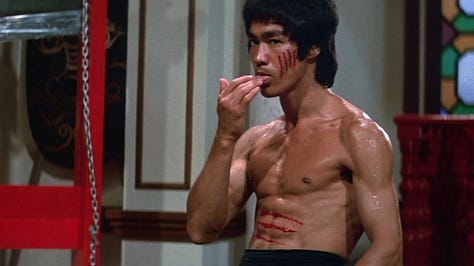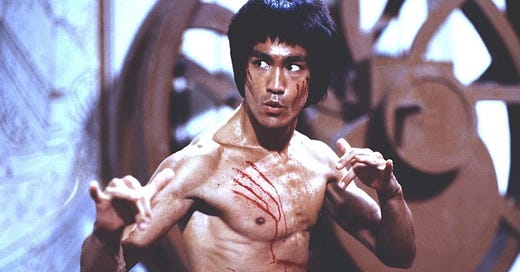ENTER THE DRAGON
1973 • Robert ClouseCast: Bruce Lee, John Saxon, Ahna Capri, Bob Wall, Shih Kien, Jim Kelly, Angela Mao Ying, Betty Chung, Geoffrey Weeks, Yang Sze
Screenplay: Michael Allin
Cinematography: Gilbert Hubbs
Music: Lalo Schifrin
Producers: Fred Weintraub, Paul Heller, Raymond Chow
Warner Bros./Golden Harvest
Man, you come right out of a comic book.
Unquestionably Bruce Lee’s most famous film, Enter the Dragon follows Lee, a martial artist who is recruited by a secret government agency to infiltrate a high-stakes martial arts tournament organized by a powerful crime lord named Han. As Lee, delves deeper into the tournament, he uncovers Han's criminal empire he faces ruthless criminals and deadly opponents. As you’re immersed in the film's intense fight scenes, Lee navigates a web of intrigue and danger. Bruce Lee's star power takes center stage, showcasing his unparalleled martial arts skills and charisma. The plot is secondary, however, to the breathtaking action that made the film a major success, and unfortunately the last of Lee’s films released in his lifetime.
Enter the Dragon stands as a monumental achievement in the world of cinema, especially within the martial arts genre. Released in 1973, the film not only achieved immense popularity during its time but also carved a permanent niche in the history of martial arts movies. While Hong Kong cinema boasts a plethora of outstanding martial arts films, Enter the Dragon remains unparalleled in terms of global recognition and influence. Its widespread success catapulted martial arts movies into the American mainstream, while also making them a cultural phenomenon worldwide.
Enter the Dragon manages to transcend its era, showcasing a timeless appeal that continues to captivate audiences. Although the fashion choices (those wide lapels, man) and dialogue might reflect the trends of the 1970s, the film's core essence, its intense action sequences, and profound philosophy remain as compelling today as it was five decades ago. OK, the afros may be a bit much, but the heart-pounding action sequences and philosophical depth of the film are what really matter here. The choreography of the fight scenes, meticulously crafted to highlight Lee's martial arts expertise, remains awe-inspiring, showcasing a level of physical prowess and agility that continues to leave you breathless.
Lee had a good deal of creative control over the film, which explains the deep philosophical monologues he delivers, exploring themes such as inner strength, discipline, and the battle between good and evil. These themes transcend the boundaries of time and culture. Bruce Lee's teachings in the film are timeless wisdom, inspiring not just to martial artists but to anyone striving for personal growth and self-discovery. Enter the Dragon is often credited as kick-starting an American mainstream trend of martial arts in pop culture. One of the film's remarkable aspects is its ability to bridge cultural gaps and resonate with diverse audiences, transcending language barriers to deliver a universal message of bravery, honor, and the triumph of good over evil. This is evident in Jim Kelly, a black man, being cast in a prominent role. The Civil Rights era was not that far in the past at the time of the film’s release, and having a Chinese lead and a black co-star in a major Hollywood-financed production was (unfortunately) a radical concept, but it worked. While there were a plethora of both Hong Kong imports and American copycats, Dragon stands as a beacon of excellence. Bruce Lee's magnetic presence ensures that the film's legacy will continue to endure, making it a classic that will be celebrated for generations to come.
Martial arts movies, much like musicals and their songs, operate on a unique storytelling dynamic where the plot serves as a vehicle to transition from one spectacular fight sequence to another. In this realm, the storyline often plays a secondary role, merely providing a framework for the action-packed moments that truly define the genre. Just as musicals are built around show-stopping musical numbers, martial arts films are structured to showcase breathtaking fight choreography. The plot, while serviceable and necessary to give context to the characters and their motivations, takes a backseat to the visceral thrill of combat. Enter the Dragon epitomizes this concept. While the narrative provides a foundation for the characters' journey, it's the impeccably crafted fight sequences that steal the spotlight. Each punch, kick, and acrobatic move is meticulously choreographed, transforming the film into a visual symphony of martial arts prowess. Also for an extra bit of fun, keep an eye out for future superstars Sammo Hung and Jackie Chan, who both pop up.
The tragic passing of Bruce Lee just days after the Hong Kong premiere of Enter the Dragon sent shockwaves throughout the world. His untimely death marked the loss of an iconic figure whose influence extended far beyond the realm of martial arts. The global outpouring of grief highlighted the profound impact he had made, not just as a martial artist and actor but also as a cultural phenomenon.
In the wake of Lee's passing, his final project, Game of Death, remained unfinished. Golden Harvest, keen to capitalize on the immense success of Lee's previous films, made the decision to complete the movie using the footage Lee had shot before his death. Although the use of Lee's scenes without his permission raised ethical questions, the film was ultimately released, using stunt doubles for wide shots featuring Lee’s character Billy Lo for new scenes. It featured pretty good fight sequences, including memorable bouts with actors like Kareem Abdul-Jabbar and Chuck Norris. Despite the controversy surrounding its production, Game of Death became a box-office success, a testament to Bruce Lee's enduring popularity.
Additionally, Bruce Lee's legacy lived on in unexpected ways. The famous yellow and black jumpsuit he wore in Game of Death became an iconic symbol, forever associated with his image. This distinctive outfit was later paid homage to in Quentin Tarantino's film Kill Bill, where Uma Thurman's character donned a similar jumpsuit in a nod to Lee's legacy. This tribute further solidified Bruce Lee's impact on popular culture, reminding audiences of his enduring influence on the world of cinema and beyond.
Remember: the enemy has only images and illusions behind which he hides his true motives. Destroy the image and you will break the enemy.
Notable Awards & Accomplishments
National Film Registry: Inducted in 2004
Worldwide Box Office: $100,000,000 ($660,000,000 adjusted for inflation)
Streaming: Fandango
Digital Rental/Purchase: Available at most major digital retailers
Physical Media: Available on 4K, Blu-Ray and DVD. Part of the Criterion Collection
